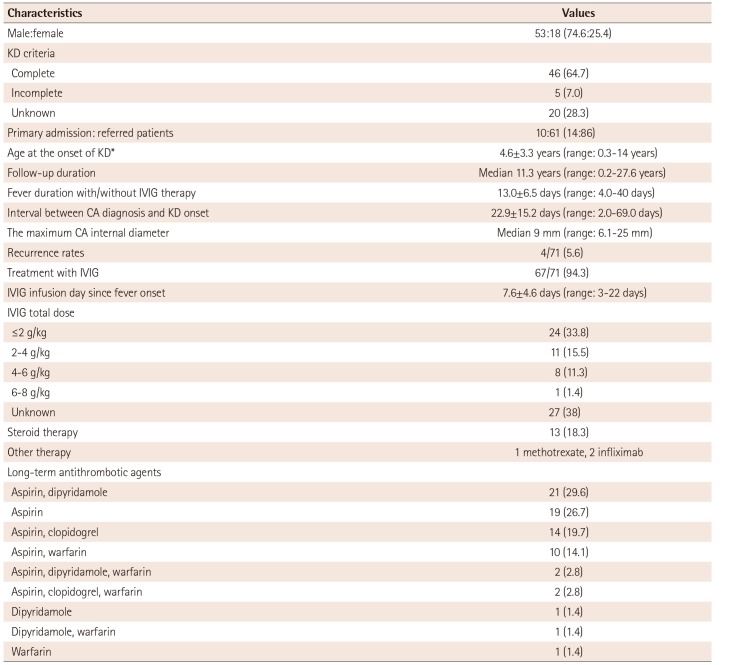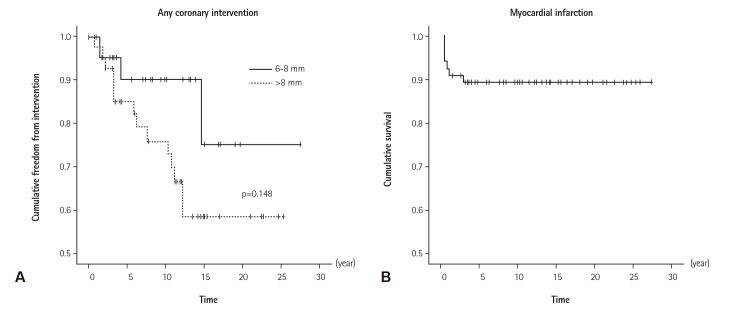1. Yanagawa H, Nakamura Y, Yashiro M, Uehara R, Oki I, Kayaba K. Incidence of Kawasaki disease in Japan: the nationwide surveys of 1999-2002. Pediatr Int. 2006; 48:356–361. PMID:
16911079.
2. Newburger JW, Takahashi M, Gerber MA, et al. Diagnosis, treatment, and long-term management of Kawasaki disease: a statement for health professionals from the Committee on rheumatic fever, endocarditis and Kawasaki disease, Council on cardiovascular disease in the young, American heart association. Circulation. 2004; 110:2747–2771. PMID:
15505111.
3. Uehara R, Belay ED. Epidemiology of Kawasaki disease in Asia, Europe, and the United States. J Epidemiol. 2012; 22:79–85. PMID:
22307434.
4. Onouchi Z, Hamaoka K, Sakata K, et al. Long-term changes in coronary artery aneurysms in patients with Kawasaki disease: comparison of therapeutic regimens. Circ J. 2005; 69:265–272. PMID:
15731529.
5. Kato H, Sugimura T, Akagi T, et al. Long-term consequences of Kawasaki disease. A 10- to 21-year follow-up study of 594 patients. Circulation. 1996; 94:1379–1385. PMID:
8822996.
6. Kato H, Koike S, Yamamoto M, Ito Y, Yano E. Coronary aneurysms in infants and young children with acute febrile mucocutaneous lymph node syndrome. J Pediatr. 1975; 86:892–898. PMID:
236368.
7. Suda K, Iemura M, Nishiono H, et al. Long-term prognosis of patients with Kawasaki disease complicated by giant coronary aneurysms: a single-institution experience. Circulation. 2011; 123:1836–1842. PMID:
21502578.
8. Jang GY, Kang IS, Choi JY, et al. Nationwide survey of coronary aneurysms with diameter >6 mm in Kawasaki disease in Korea. Pediatr Int. 2015; 57:367–372. PMID:
25406095.
9. Akagi T, Rose V, Benson LN, Newman A, Freedom RM. Outcome of coronary artery aneurysms after Kawasaki disease. J Pediatr. 1992; 121(5 Pt 1):689–694. PMID:
1432415.
10. AlHuzaimi A, Al Mashham Y, Potts JE, De Souza AM, Sandor GG. Echo-Doppler assessment of arterial stiffness in pediatric patients with Kawasaki disease. J Am Soc Echocardiogr. 2013; 26:1084–1089. PMID:
23800509.
11. Gong F, Shiraishi H, Momoi MY. Follow-up of coronary artery lesions caused by Kawasaki disease and the value of coronary angiography. Chin Med J (Engl). 2002; 115:681–684. PMID:
12133534.
12. Peng Y, Zeng J, Du Z, Sun G, Guo H. Usefulness of 64-slice MDCT for follow-up of young children with coronary artery aneurysm due to Kawasaki disease: initial experience. Eur J Radiol. 2009; 69:500–509. PMID:
18164157.
13. Sohn S, Kim HS, Lee SW. Multidetector row computed tomography for follow-up of patients with coronary artery aneurysms due to Kawasaki disease. Pediatr Cardiol. 2004; 25:35–39. PMID:
14583832.
14. Ohmoto-Sekine Y, Ishihara M, Hsieh SD, et al. Giant coronary artery aneurysms associated with Kawasaki disease detected on whole-heart magnetic resonance coronary angiographic screening. Intern Med. 2013; 52:977–980. PMID:
23648717.
15. Kitamura S, Kameda Y, Seki T, et al. Long-term outcome of myocardial revascularization in patients with Kawasaki coronary artery disease. A multicenter cooperative study. J Thorac Cardiovasc Surg. 1994; 107:663–673. discussion 673-4. PMID:
8127095.
16. Gu C, Fan S, Zhou H, et al. Surgical treatment of giant coronary artery aneurysm secondary to Kawasaki disease. Heart Surg Forum. 2009; 12:E241–E243. PMID:
19683998.
17. Waki K, Arakaki Y, Mitsudo K. Long-term outcome of transcatheter polytetrafluoroethylene-covered stent implantation in a giant coronary aneurysm of a child with Kawasaki disease. Catheter Cardiovasc Interv. 2013; 81:713–716. PMID:
22605684.
18. Muta H, Ishii M. Percutaneous coronary intervention versus coronary artery bypass grafting for stenotic lesions after Kawasaki disease. J Pediatr. 2010; 157:120–126. PMID:
20304414.
19. Kato H, Ichinose E, Kawasaki T. Myocardial infarction in Kawasaki disease: clinical analyses in 195 cases. J Pediatr. 1986; 108:923–927. PMID:
3712157.
20. Harada M, Akimoto K, Ogawa S, et al. National Japanese survey of thrombolytic therapy selection for coronary aneurysm: intracoronary thrombolysis or intravenous coronary thrombolysis in patients with Kawasaki disease. Pediatr Int. 2013; 55:690–695. PMID:
23919576.
21. Lee J, Kim GB, Kwon BS, Bae EJ, Noh CI. Two cases of super-giant coronary aneurysms after kawasaki disease. Korean Circ J. 2014; 44:54–58. PMID:
24497892.
22. Muta H, Ishii M, Iemura M, Matsuishi T. Health-related quality of life in adolescents and young adults with a history of Kawasaki disease. J Pediatr. 2010; 156:439–443. PMID:
19969307.








 PDF
PDF ePub
ePub Citation
Citation Print
Print


 XML Download
XML Download